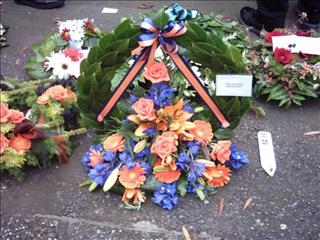During World War I, the Indian Army (then called the British Indian Army), contributed a number of divisions and independent brigades to the European Front in West, Mediterranean and the Middle East theatres of war.
A million Indian troops served overseas, of who 62,000 died and 67,000 were wounded. These included 1926 soldiers killed and 3863 wounded at Gallipoli, while fighting for the Australian-New Zealand Division, as a part of Australia New Zealand Army Corps (ANZAC).
Tens of thousands of New Zealanders observe ANZAC Day on April 25 with reverence at home and far across the oceans at Gallipoli in Turkey.
On this day, the Nation remembers its forefathers who fought in wars far away from home (many never returned) in the two World Wars and in other campaigns in more recent times.
ANZAC Day builds bridges across communities and unites generations of Kiwis, who gather at war memorials all over the land to commemorate those who gave their lives for their country, to honour those war veterans who made it back home and to pay tribute to the serving members of the Armed Forces.
Multinational body
Despite being synonymous with Australia and New Zealand, ANZAC was a multinational body. In addition to the many British officers in the corps and division staffs, it contained elements of the Indian Expeditionary Force G, which was primarily 29 Infantry Brigade, comprising two Punjabi battalions, King George’s Own (KGO) Ferozepore Sikhs and , I/5 GR with mountain batteries.
The present incarnation of 69 Punjabis (The First Battalion of the Brigade of Guards) is the senior most infantry battalion of the Indian Army, proudly displaying Gallipoli as one of its 31 Battle Honours along with Heles and Krithia from the same sector. The other infantry battalions, still on Order of Battle (ORBAT) of the Indian Army also cherish their battle honours earned in the Gallipoli Sector of Dardanelles.
Keeping the sensitivity of 33% Muslim troops of two Punjabi battalions to fight Khalifa’s Company of religionist troops, these battalion were withdrawn and sent to France, to be replaced by ¼ GR, 1/6 GR and 2/10 GR.
The brigade marches
The brigade was dispatched from Egypt and attached to the British 29th Division, which had been decimated in the earlier battles. Held in reserve for the Second Battle of Krithia, they played a major part in the Third Battle of Krithia. Advancing on the left the Brigade was quickly halted except along the Aegean shore, where the 1/6th Gurkha Rifles managed to advance.
The 14th KGO Sikhs, advancing along the floor of Gully Ravine, were almost wiped out, losing 380 men out of 514 and 80% of their officers.
The Brigade was next involved in the Battle of Gully Ravine and here the 2/10th Gurkha Rifles managed to advance half a mile. The Brigade next took part in the Battle of Sari Bair, under cover of a naval bombardment the 1/6th Gurkha Rifles assaulted and captured the hill, which was then shelled by the Royal Navy.
With their casualties mounting, they were forced to withdraw to their starting positions under command of the battalion medical officer.
Officially, India’s contribution to the Great War includes its participation in Gallipoli British officers (BO’s) and British Other Ranks (BORs).
Indians who made the supreme sacrifice in the Helles sector were commemorated on the Memorial at Cape Helles.
Indians ignored
ANZAC Day celebrations tend to ignore the contribution of the Indians, plausibly because as an erstwhile colony, India’s military contribution was taken for granted, as it had no independent political resonance.
Indian participation in Gallipoli was substantial and contributed immensely to the operations.
The fighting component of ANZAC comprised 23 Infantry Battalions, 15 of which came from Australia, five India and three from New Zealand.
Most publications, including books, on the Gallipoli campaign make little, if any mention of the contributions of the Indians to this gallant, if doomed, attempt to gain the Bosporus and defeat the Ottomans.
Few therefore realise that the much celebrated achievements, as well trials and tribulations of ANZAC at the Dardanelles, hailed as defining points in the New Zealand and Australian history, were also shared by a large contingent of the Indian Army Corps.
The Gallipoli Campaign did not make a large mark in the history of the Great War. The number of dead, although horrific, paled in comparison with the number that died in France and Belgium.
Heavy casualties
 But for New Zealand, along with Australia and Turkey, the Gallipoli campaign left a lasting impression on the national psyche. By the time the campaign ended, almost 125,000 men had died, including 80,000 Turks and 44,000 Allied soldiers.
But for New Zealand, along with Australia and Turkey, the Gallipoli campaign left a lasting impression on the national psyche. By the time the campaign ended, almost 125,000 men had died, including 80,000 Turks and 44,000 Allied soldiers.
For nine months, Australians and Indians with allies from France and the British Empire battled harsh conditions and resolute Turkish opponents who were desperately fighting to protect their homeland.
Indian, New Zealand and Australian troops were part of ANZAC that fought at Gallipoli. Of 5010 Indians who served in ANZAC, 1926 died and 3863 were wounded, some more than once. New Zealand and Australia had larger contingents and their Killed In Action (KIA) causalities were 2741 and 7594 respectively.
This anomaly should be corrected and the contribution of the Indian troops acknowledged during the observance of ANZAC Day, not just in Australia and New Zealand but also in India.
Carl James served the Indian Navy from 1967 and following retirement in 1990, was employed in Merchant Navy. He lives in Auckland. Ravee Sahrawat served the Indian Army from 1964, served in the First Regiment of the Brigade of the Guards and retired as Colonel. He lives in Wellington. The above article, sent to us early last month to commemorate ANZAC Day on April 25, was held over for lack of space.






